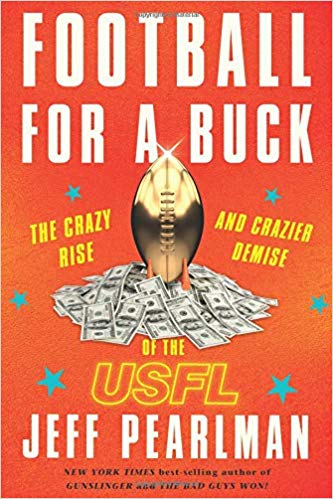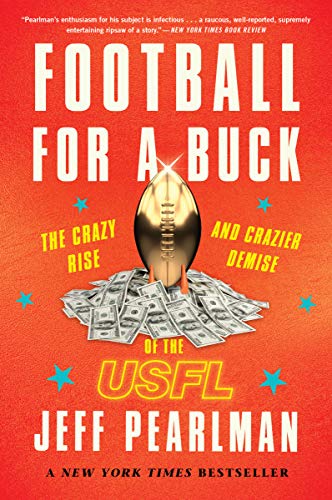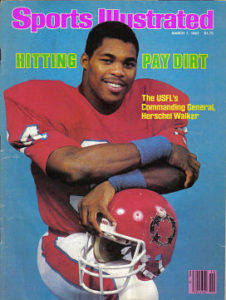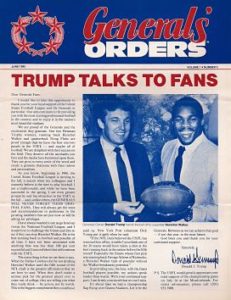Back in the winter of 1983, a maniacal coach named George Allen auditioned more than 3,000 men to play for his Chicago Blitz franchise in the start-up United States Football League. Allen, who was (apocryphally) killed via by Gatorade bath at the hands of his own players in 1990 and (actually) inducted into the Pro Football Hall of Fame in 2002, was a legendary fanatic for details. But the mechanics of evaluating and segmenting dreamers & strivers on such an industrial scale will inevitably break down. Someone will figure out how to hack the machine.
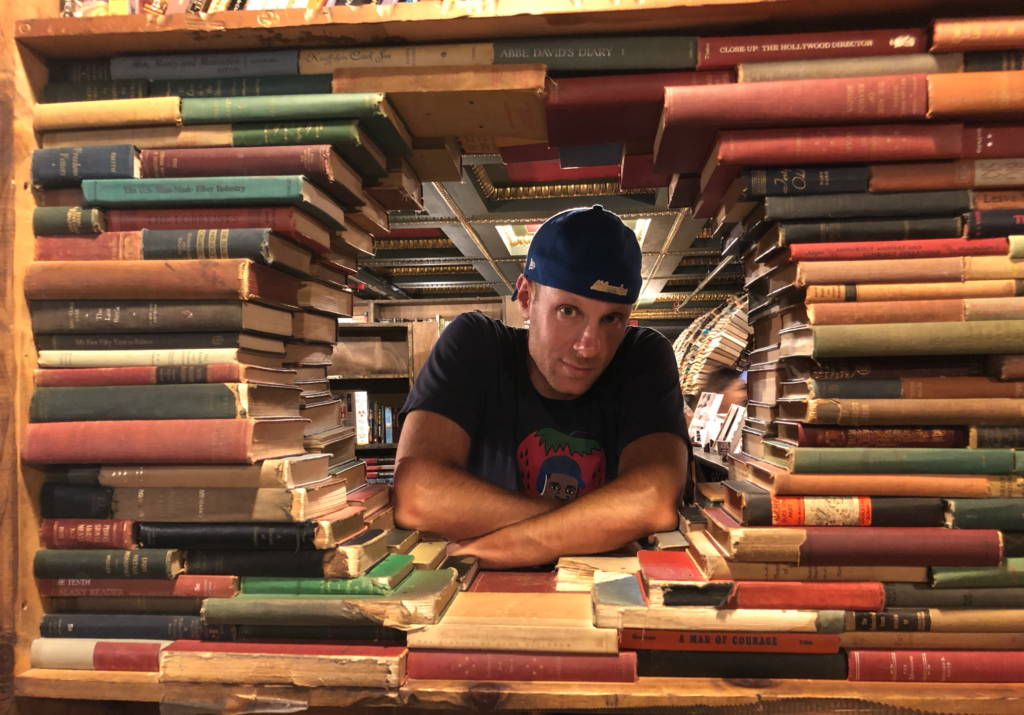
“Have you heard of Albert C. Lynch?” Jeff Pearlman asks me. I’ve reached the author at his California home at one minute before midnight on opening night of the 2018 NFL season. Moments earlier, the Eagles and Falcons wrapped up a wretched, over-officiated mess of a debut. Philly fans booed the Iggles on their first game back home after winning the first Super Bowl in franchise history. It was the kind of joyless slog that makes you wish somebody would try to blow up the NFL and start all over again.
“The Chicago Blitz held massive amounts of tryouts. They tried out more than 3,000 guys. The Blitz had this system where Bruce Allen, their GM, would sit in the stands during mini-camp. The coaches would send guys they wanted to sign up to Allen in the stands. There was this one guy named Albert C. Lynch … he was a 5’ 6” linebacker who never played anywhere and he sucked. But he saw the system and figured it out. So he walked into the stands and Bruce Allen signs him to a contract. Later on they’re going through the contracts and the coaches say ‘You signed Albert C. Lynch?’ And Bruce Allen’s like ‘Well, you sent him to me.’ Each coach is like ‘I didn’t sent you Albert C. Lynch!’ And then all of a sudden they’re like ‘Ahhh. That guy got us!’ They still joke about Albert C. Lynch today.”
Editor's Pick
Football For A Buck
The Crazy Rise and Crazier Demise of the USFL
By Jeff Pearlman
The United States Football League—known fondly to millions of sports fans as the USFL—did not merely challenge the NFL, but cause its owners and executives to collectively shudder. In its three seasons from 1983-85, it secured multiple television deals, drew millions of fans and launched the careers of legends such as Steve Young, Jim Kelly, Herschel Walker, and Reggie White. But then it died beneath the weight of a particularly egotistical and bombastic team owner—a New York businessman named Donald J. Trump.
In Football for a Buck, Jeff Pearlman draws on more than four hundred interviews to unearth all the salty, untold stories of one of the craziest sports entities to have ever captivated America. From 1980s drug excess to airplane brawls and player-coach punch outs, to backroom business deals and some of the most enthralling and revolutionary football ever seen, Pearlman transports readers back in time to this crazy, boozy, audacious, unforgettable era of the game. He shows how fortunes were made and lost on the backs of professional athletes and how, forty years ago, Trump was already a scoundrel and a spoiler.
When you make a purchase through an affiliate link like this one, Fun While It Lasted earns a commission at no additional cost to you. Thanks for your support!
Pearlman is a best-selling biographer of NFL icons and an OK-selling biographer of Major League Baseball steroid guys. His latest, out September 11th, is Football For A Buck: The Crazy Rise and Crazier Demise of the USFL and it’s a departure from The Format; a legit passion project that has been percolating since at least his senior year of high school in 1990. It’s also his first book without a built-in mass audience. Pearlman hit a brick wall for years trying to sell the project. He finally succeeded by taking a haircut on his fee and packaging Football For A Buck to Houghton Mifflin Harcourt as a combo with Gunslinger, his 2016 Brett Favre bio.
Pearlman seems acutely aware of the book’s uncertain sales prospects and that his agent and publisher may ultimately come to view Football For a Buck on a spectrum that ranges from Big Short-esque artistic & commercial triumph to Simple Jack-style fit of self-indulgence. As a result, he’s spent the past two weeks on a relentless and indiscriminate PR campaign. In between cross-country flights and guest spots with ESPN’s Bob Ley and other heavy hitters, Pearlman’s been mailing thank you packages stuffed with Chicago Blitz stickers and signed book plates to any reader who will email him a screen shot of their Amazon pre-order. And swapping USFL stories with every podcaster and blogger with a 56K modem.
Count me as a fan of this approach. Fun While It Lasted is firmly cut from the the Albert C. Lynch mold of digital ability and repute. If Pearlman’s book hustle game didn’t so thoroughly mimic George Allen’s 1983 Blitz tryout camps in scale, ambition and utter lack of quality control, my little blog would never have made it onto the field.
As usual, the following interview has been heavily edited & expanded to reduce clarity and misrepresent the views of its subject. Enjoy.
Hitting Paydirt – 1983
FWiL:
You’ve said that you never attended a USFL game, but you followed the league religiously on TV and then wrote a 40-page paper about the league in high school. Why do you feel like this league imprinted itself on you so much as a kid?
I can tell you, my son is 11. He’s gotten into jerseys with my guidance. He literally wears a different jersey to school every day. We buy the jerseys on e-Bay for like four bucks. So it’s not about the players. He has like a Terrence McGee Buffalo Bills jersey. But there’s something about the colors and the style and the fabric and there’s just something about that on a young kid’s brain sometimes that does something.
I am a lifetime Hall & Oates fan. And it all started when I was a kid and I bought my brother their H2O album. I can tell you exactly what the album cover looks like even if I haven’t seen it in 20 years. Something about that album cover, more than their music even, made me a Hall & Oates fan. There’s something that just hits us at that age, I think, little things that imprint themselves on your brain where it’s just ‘yeah, that just does it for me’.
For me [with the USFL] it was two things. It was the cover of Sports Illustrated [March 7, 1983] when Herschel Walker was on it and it said “Hitting Paydirt” and it was him in a Generals uniform. And it was inside that issue where they had a spread with all the USFL helmets. I remember looking at it. I was in the Mahopac Public Library and I just remember my mind being blown. It just did it for me. I don’t know. It just did it and here I am.
FWiL:
I know what you mean. I was seven years old when the USFL started in 1983. It was the first year I cared about sports or read the Boston Globe sports page. Boston got a USFL team called the Breakers and I loved their helmets. After a year they were gone, but then in 1985, the New Jersey Generals signed Doug Flutie out of Boston College right after he won the Heisman and I got interested again.
I remember being a freshman in high school in 1990. I was at a new school and I went to sleep over at someone’s house for the first time. This kid had a Breakers bumper sticker on his window in his bedroom and I was just transfixed by it. And I was peppering him with questions, like ‘Did you go to a game? Was Johnnie Walton the quarterback?’ And he was like ‘Fuck, I don’t remember, you weirdo.’” I remember that moment as just an early experience of very heavy nostalgia.

Pearlman:
I actually think I know what I can compare it to in a good way. This just crossed my mind. I think it’s very similar to the KISS make-up. KISS’ music – not great! So why did so many kids become KISS fans in the 1970’s? There’s something about that make-up that just appealed to the brain of a certain age. And for me, the USFL was the same thing.
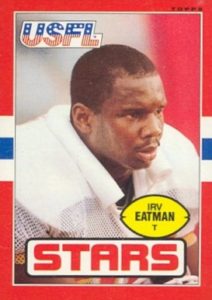 FWiL:
FWiL:
I read that you did upwards of 400 interviews for the book. Was there a player or two that had the most surprising second act after their football career was over?
Pearlman:
A ton of these guys end up coaching and a bunch end up in the ministry. Four or five of those guys ended up in professional wrestling. Jeff Gaylord, who played for the Breakers and the Gunslingers, spent years and years in professional wrestling.
Oh wait – I’ll give you a super weird one. Irv Eatman was an offensive lineman with the Philadelphia Stars. Went to UCLA and later had a very long NFL career. This is super weird. Stay with me on this one. Irv Eatman is my wife’s sister’s husband’s step mother’s daughter’s husband. So weird. I don’t even know how we came to figure that out. But now we call him ‘Uncle Irv’ in the family.
FWiL:
And did you know that before you started researching the book?
Pearlman:
No! What? No, we had no idea whatsoever.
It’s funny. On my website, I’ve been doing a ranking of the Top 25 USFL players of all-time, day-by-day. I had Irv Eatman number 18, I think. He DM’d me on Twitter and said ’18, huh? We’re going to have to talk about this at the next family reunion.’
Enter Trump
FWiL:
I’m sure you saw that [Tampa Bay Bandits part-owner] Burt Reynolds passed away today. Other than people who died, was there anyone you really wanted to talk to that you just couldn’t find or track down?
Pearlman:
Oh, the big one was Herschel. Herschel wouldn’t talk. That was a bummer. Fascinating. Obviously Herschel Walker doesn’t go down as the greatest player in USFL history, but he is probably the most important.
Did you have any Generals players that went on the record with their opinions of [Generals owner] Donald Trump politically or their experiences with him and his racial attitudes while they were on the team?
Pearlman:
Actually it’s really interesting. Most of the guys liked Trump who played for the Generals.
FWiL:
Black and white?
Pearlman:
Yeah, cause they were getting paid. I didn’t find one guy – believe me, I’m no Trump fan – I never came across a player who thought he was a racist when they were playing. In fact there was one guy who was a linebacker on the Generals who was cut in ’83 because he was seen with a white woman in the team hotel, but that was before Trump came along.
Trump, among players, was liked. It’s weird to say that. But he really was. He was all about taking care of them, all about getting them paid. His checks never bounced. If you were a player in the USFL, he would probably be the owner to play for. Because you knew you were going to get paid and treated well. It’s actually weird to hear myself say that, but it’s true.
I will tell you this. What I found was really interesting is – [these interviews] were around the time Trump was running or right after the election. The divide among among who voted for Trump and who didn’t was strongly along racial lines. I think I found one African-American player who voted for Trump. And I would say almost every white person I talked to voted for Trump. People who generally disliked Trump … well, Jerry Argovitz was the owner of the Houston Gamblers and really had very little good to say about Trump. But still voted for him. As an owner I think Trump was ruinous to the league, but I think he was great to the Generals.
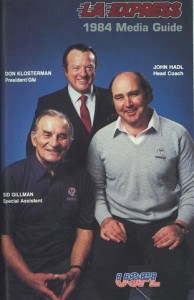 Raiding The NFL
Raiding The NFL
FWiL:
I think one of the things that was really appealing for people who are nostalgic about the USFL is this notion of a rival league raiding the college draft and poaching major free agents [from the NFL]. And there were many more flirtations that never quite happened. So my hypothetical for you – if you could have pick a couple of those high profile flirtations to come through, who do you wish the USFL could have landed?
For example, I would have loved to see the San Antonio Gunslingers actually sign Earl Campbell.
Pearlman:
No! That would have been so bad. Oh God.
FWiL:
Well, I’m glad it didn’t happen for his sake, especially knowing the toll football took on him. But I think it would have been fascinating at the time to see Campbell in San Antonio and Eric Dickerson in Arizona.
Pearlman:
I’ll give you two.
#1 – Bill Tatham was the owner of the Oklahoma Outlaws. The Tathams’ initial goal was to have a USFL team in San Diego. They negotiated and reached a deal with Dan Fouts of the San Diego Chargers to sign with the USFL. Fouts was about to be a free agent and he really did not get along well with the Chargers ownership at the time. He hated them. It was a weird thing where he had this moment of pause before signing. Fouts started getting nostalgic about how close they came to reaching the Super Bowl [in ‘81]. Tatham said to him ‘Listen. Take the offer I made to you to the Chargers. And if they match it, go back to the NFL.’ That’s kind of impressive. That’s what Fouts did and he went back to the NFL. But he would have been perfect for the USFL.
#2 – Obviously Lawrence Taylor going to the Generals would have been insane. And they brought in Mark Gastineau and Randy White [for contract talks] also. Imagine you had Lawrence Taylor, Gastineau and Randy White on a defense coached by Don Shula.
FWiL:
And did I read that Don Shula wanted an apartment in Trump Tower and that was the deal breaker for him leaving the Miami Dolphins to become coach of the Generals in 1984?
Pearlman:
Well, what really happened is they were negotiating back and forth. Trump went on TV and said they were negotiating with Shula and were very close. I think that same day the Dolphins played the Colts. In the post-game press conference, like the third question Shula got was about possibly going to New Jersey. Shula was livid with Trump that he let that out. In that moment decided not to do it. And he had been asking for an apartment as part of a deal. And Trump, being Trump, then said well, it was never going to happen because Shula was being greedy asking for the apartment. Trump, who never takes rejection even remotely well, laid it at the feet of Shula.
The End – 1986
FWiL:
Last question that I’ve always been curious about. So they’re getting ready for 1986, the lawsuit is going on, there’s eight teams left. Was there a legitimate effort going on to prepare to play that season? Were there going to be training camps, and were they scouting players and selling tickets? Or were they just sitting back [on the NFL anti-trust suit] and thinking we are either going out of business or we are getting a big fat payday, but they aren’t really trying much else?
Pearlman:
You know it’s actually an inexact answer. There were some teams that were legit trying. The Bandits had a camp. The Generals and Gamblers merged. There was a real idea briefly – the [Generals] held a mini-camp with Jim Kelly and Herschel Walker. The funny thing is you go back there and it’s, like, fantastical. People like Donald Trump, Jerry Argovitz, Jim Kelly are literally talking about how the Kelly-Herschel Generals would give the ’85 Chicago Bears a really good game. They’d light ‘em up. And it’s like – no they wouldn’t. Gimme a break pal.
The best USFL team was the Philadelphia/Baltimore Stars. That’s probably an 8-8 or 7-9 NFL team. And that’s not me. That’s [Stars quarterback] Chuck Fusina saying that. Jim Kelly and Herschel Walker were great players, but you still had an offensive line that was probably 15 pounds lighter than an NFL line, you had a very unremarkable defense, you had one good cornerback. It was just all stupid talk, you know.
Plugs & Links
Alright. If you made it this far (which is the end, by the way), then it’s time to order Jeff’s book if you haven’t already, follow Jeff on Twitter @JeffPearlman.
Good Seats Still Available Podcast #78: The United States Football League with Jeff Pearlman
##

